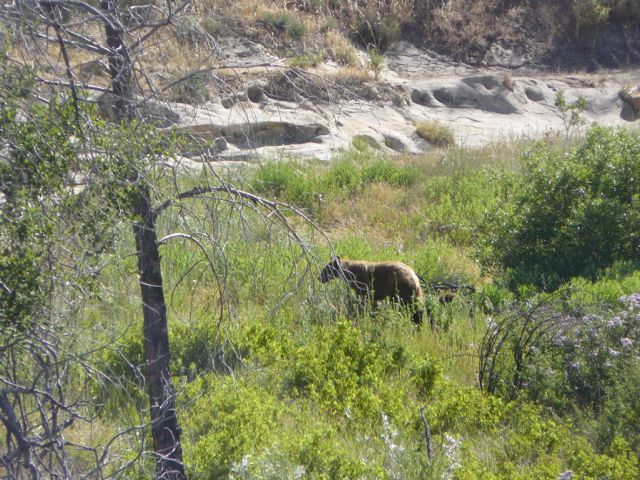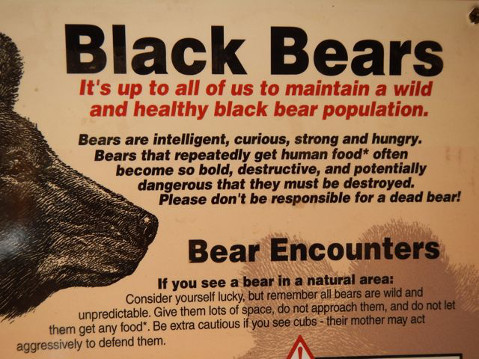Hiking, Dogs, and Bears
Not All Animals Belong in the Backcountry

While our three-year drought punishes the Santa Barbara backcountry as much as it does our urban “front country” enclave, the animals are getting the worst of it and behaving erratically as a result. Raccoons crawl over my Westside backyard nightly, a 15-pound bobcat attacked a woman at Solvang’s Alisal Ranch in late September, and a bear attacked a Carpinteria woman out day-hiking with her two dogs on September 22. That Carpinteria black bear was munching on ripe avocados when Emily Miles’s two dogs charged it, then led the irritated bear back to the woman, whom it promptly knocked down and bit.
Backpacking and dayhiking here since 1971, I’ve only encountered three bears over these four decades tramping around our vast Santa Barbara backcountry: All three bears ran away the instant I appeared. I chased after one of them while trying to photograph it and shocked my 12-year-old son with such rash behavior.
The intricate ways our indigenous bears interact with expanding human civilization, loss of habitat, and intrusions by hiking humans and dogs weaves quite a tale. There have also been recent cases, e.g. on the Santa Cruz Trail to Little Pine Mountain (behind Upper Oso), where a trail runner’s dog threatened two L.A. hunters, so one hunter shot and killed the dog.
The Indy‘s article about the bear attack in Carpinteria has elicited a short but informative thread of comments. One says,”Dogs can rustle up and agitate all manner of critters, such as rattlesnakes, mountain lions, and bears.”
In more than 40 years chatting with backcountry hikers, no one has ever told me a California black bear attacked them. Two years ago, a hiking buddy took the photograph above of a California black bear with two cubs about 11 miles inside the San Rafael Wilderness. He told me he promptly left the area since he worried the cubs would get curious about him.
More than 25,000 black bears are estimated to live in California, but our arid backcountry means we have a much lower bear population density than many parts of Northern California. In a recent five-year period, says The Indy‘s bear article, 1,218 “bear depredation licenses” were issued in our state, and these led to the killing of 322 bears. Last year, California issued 24,000 bear-killing permits, and almost 2,000 more bears were slain, six of them in Santa Barbara County. They call this “harvesting” bears.
It is important to look more closely at the most recent human-bear confrontation in Carpinteria: The courageous 65-year-old woman was injured but survived (broken rib, bite on her thigh). She was hiking from her home in the Rincon Valley area within a mile radius of the intersection of Highway 192 and Highway 150 (leading to Lake Casitas). Like a hiker in Ojai in 2012, Miles had two unleashed dogs with her, and she thinks her Queensland terrier may have spooked this bear.
How wonderful that the bear got away and was not captured and killed by the state and that Ms. Miles never wanted the bear harmed. California black bears (Ursus Americanus californiensis) may not have always been here, since the much larger California grizzly bear (Ursus arctos californicus) likely kept it away. Humans killed off these more ferocious bears by 1870 or 1900, depending on what book you read.
Our delightful California black bears have lost a lot of their habitat to the explosion of human habitations and industrial development — this obviously means there will be increasing contact between hiking humans and our wild bears. These 300-pound mammals typically do not attack or eat human beings unless provoked.
Another factor increasing bear-human contacts is the unique way California has many wilderness zones pushing right up against highly urbanized regions. California alone contains over 55 federal “wilderness” tracts.
We have to look at the negative role of the unleashed dogs, too. I like and enjoy dogs under certain conditions, but when unleashed, they’re inappropriate in the near-wilderness behind Carpinteria, as well as in the true wilderness backcountry behind Santa Barbara.
Domesticated canines are as unnatural to the Santa Barbara backcountry as some urbanites might be. They can be easily injured in the backcountry, and they also tend to rile up indigenous populations (like bears and mountain lions). My friend/guru Franko lost his small dog to a rattlesnake bite in the backcountry a few years back.

The folks at Devils Postpile National Monument in the eastern Sierra deal with the human-dog-bear interface constantly, as I could see when visiting there in October. In order to protect their bears from having to be killed by the state, all dogs in the Monument area have to be leashed. As the poster states, “Bears are intelligent, curious, strong, and hungry.” On October 1, I saw plenty of dogs on the easy trail to the Devils Postpile and famous Rainbow Falls, and every single one was securely on a leash, and many were muzzled.
Humans’ beloved canines need to be protected from rattlesnakes, bears, ticks, and other dangerous wilderness organisms, just as our wonderful black bears need protection from humans’ excited and passive-aggressive dogs.
Just as there are no “bad” children (only bad parents), there are no “bad” dogs, although there are many canine owners who unthinkingly bring their domesticated dogs into the wild habitat and range of resident California black bears. There are wilderness zones near San Francisco, for example, where no dogs are allowed at all in order to protect the natural environment, including state parks like Portola, Henry Cowell, and the famous Big Basin Redwoods Park.
It really is up to us to maintain a wild and healthy black bear population as well as protect our pets. We need to leash our dogs whenever hiking along the near-wilderness edges of cities like Santa Barbara and Carpinteria. “Voice control” will not suffice in most emergencies involving your dog and a bear.


